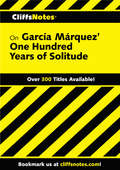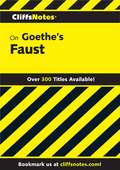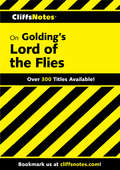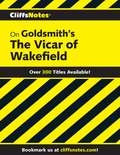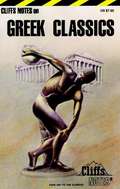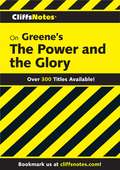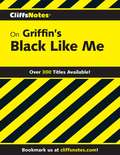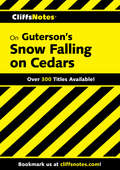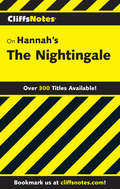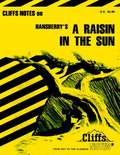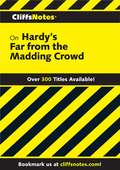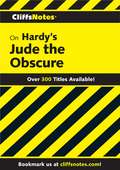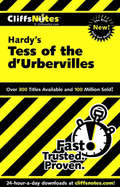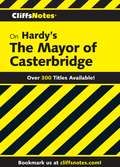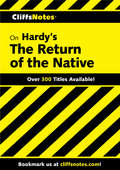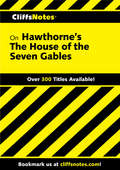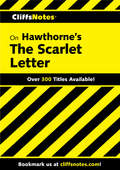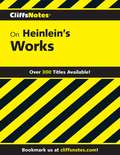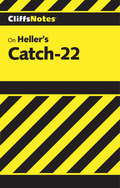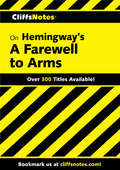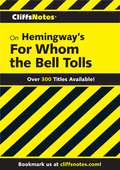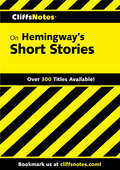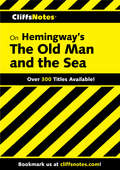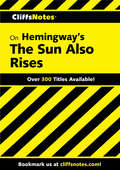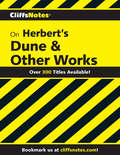- Table View
- List View
CliffsNotes on Garcia Marquez' One Hundred Years of Solitude
by Carl SennaThis CliffsNotes guide includes everything you've come to expect from the trusted experts at CliffsNotes, including analysis of the most widely read literary works.
CliffsNotes on Goethe's Faust, Part 1 and 2
by Robert J MilchThis CliffsNotes guide includes everything you've come to expect from the trusted experts at CliffsNotes, including analysis of the most widely read literary works.
CliffsNotes on Golding's Lord of the Flies
by Maureen KellyThe original CliffsNotes study guides offer expert commentary on major themes, plots, characters, literary devices, and historical background. The latest generation of titles in this series also feature glossaries and visual elements that complement the classic, familiar format.CliffsNotes on Lord of the Flies takes you on an exploration of William Golding's novel to the dark side of humanity, the savagery that underlies even the most civilized human beings. Follow Golding's group of young boys from hope to disaster and watch as they attempt to survive their uncivilized, unsupervised, and isolated environment.You can rely on CliffsNotes on Lord of the Flies for character analyses, insightful essays, and chapter-by-chapter commentaries to ensure your safe passage through the rich symbolism of this novel. Other features that help you study includeA brief synopsis of the novelA character map to help you see relationships among the charactersA glossary that helps you get the most out of your readingAn interactive quiz to test your knowledgeEssay topics and review questionsClassic literature or modern modern-day treasure -- you'll understand it all with expert information and insight from CliffsNotes study guides.
CliffsNotes on Goldsmith's The Vicar of Wakefield
by James L RobertsThis CliffsNotes guide includes everything you’ve come to expect from the trusted experts at CliffsNotes, including analysis of the most widely read literary works.
CliffsNotes on Greek Classics
by Mary Ellen SnodgrassCliffs Notes on Greek Classics is the only reference book you need to understand the ideological and literary influence of the Greek civilization. A fully-indexed guide designed for students of: English Literature World Literature Classical Literature and Languages Philosophy History Theater and Drama Women's Studies Music and Art ReligionUse for concise overviews of Greek playwrights, poets, prose writers, historians and philosophers.Find term paper ideas and essay topics.Check facts, dates, spelling and pronunciation.Identify major Greek literary movements.Understand the origins of Western drama.Discover the genesis of such ideas as the Oedipus Complex, the Golden Mean, the Golden Fleece, the Trojan Horse, the Socratic Method and Platonic Love.Recognize literary allusions to people and events such as the Olympic Games, the Bronze Age, the Fates, Medea, Electra and the Muses.Comprehend, through example, such literary terms as medias res, hubris and nemesis.Place Greek authors in historical context and chronological relationship to one another.Review major events of Greek civil wars as discussed by such writers as Herodotus, Xenophon and Thucydides.Recognize the roots of Western thought and philosophy in such writers as Plato, Aristotle and Socrates.For comprehensive, in-depth treatment of the following works, see the Cliffs Notes on each title: Iliad; Odyssey; Agamemnon; Oedipus Rex; Electra & Medea; Lysistrata; Plato's Euthyphro, Apology, Crito and Phaedo; Plato's Republic and Aristotle's Ethics.
CliffsNotes on Greene's The Power and the Glory (Cliffsnotes Ser.)
by Edward A KopperThis CliffsNotes guide includes everything you’ve come to expect from the trusted experts at CliffsNotes, including analysis of the most widely read literary works.
CliffsNotes on Griffin's Black Like Me
by Margaret MansfieldThis CliffsNotes guide includes everything you've come to expect from the trusted experts at CliffsNotes, including analysis of the most widely read literary works.
CliffsNotes on Guterson's Snow Falling on Cedars
by Richard P WasowskiThe original CliffsNotes study guides offer expert commentary on major themes, plots, characters, literary devices, and historical background. The latest generation of titles in this series also feature glossaries and visual elements that complement the classic, familiar format.In CliffsNotes on Snow Falling on Cedars, you explore David Guterson's bestselling novel, in which a murder trial forces the residents of an island in the Pacific Northwest to revisit the time in history when both the Japanese and Japanese-Americans were discriminated against. The novel explores the effects of war, the difficulties of race, and the mystery of human motivation in a story that's a combination murder mystery, courtroom drama, and tragic love story.Summaries and commentaries guide you through the novel, and critical essays help you understand the author's narrative techniques, use of details, and symbolism. Other features that help you study includeA section on the life and background of David GutersonA section on the historical background of the novelA character listAdditional critical essays on the role of gender and use of duality in the novelReview questions and essay topicsClassic literature or modern-day treasure—you'll understand it all with expert information and insight from CliffsNotes study guides.
CliffsNotes on Hannah's The Nightingale
by Gregory ColesCliffsNotes on Kristin Hannah's The Nightingale includes everything you've come to expect from the trusted experts at CliffsNotes. Features of this Lit Note include:Focused summaries of the plot and analysis of important themes, symbols, and character developmentCharacter analyses of major characters, focusing on what motivates each characterBrief synopsis of the novelShort quiz
CliffsNotes on Hansberry's A Raisin in the Sun
by Rosetta JamesThe original CliffsNotes study guides offer expert commentary on major themes, plots, characters, literary devices, and historical background. The latest generation of titles in this series also feature glossaries and visual elements that complement the classic, familiar format.A Raisin in the Sun debuted in the spring of 1959 and has since been translated into more than 30 languages. It is the story of a poor black family struggling to become part of the middle class. Family hardships test the faith of all involved and the result is unexpected and filled with heartbreak.CliffsNotes on A Raisin in the Sun helps you explore this play by providing you with summaries and commentaries, chapter by chapter. You’ll also gain insight into the author Lorraine Vivian Hansberry. Other features that help you study includeA list of characters and their descriptionsA genealogy chart to illustrate the relationships between the charactersGlossaries to help you fully understand the novelCritical essays on thematic structure, language and style, and moreSuggested essay topics and related research projects for more studyClassic literature or modern-day treasure—you'll understand it all with expert information and insight from CliffsNotes study guides.
CliffsNotes on Hardy's Far from the Madding Crowd
by R E JonssonThis CliffsNotes guide includes everything you've come to expect from the trusted experts at CliffsNotes, including analysis of the most widely read literary works.
CliffsNotes on Hardy's Jude the Obscure
by Frank H. Thompson Jr.This CliffsNotes guide includes everything you’ve come to expect from the trusted experts at CliffsNotes, including analysis of the most widely read literary works.
CliffsNotes on Hardy's Tess of the d'Urbervilles
by Jeff CoghillThe original CliffsNotes study guides offer expert commentary on major themes, plots, characters, literary devices, and historical background. The latest generation of titles in this series also feature glossaries and visual elements that complement the classic, familiar format.In CliffsNotes on Tess of the d'Urbervilles, you explore Thomas Hardy's literary classic as the author challenges many of the Victorian sensibilities of the 19th century by writing about such topics as immoral sex, murder, illegitimate children, and the unmarried living together. In the novel, you follow the journey of Tess as early events in her life lead her down the road to tragic ruin.Chapter summaries and commentaries take you through Tess's journey, and critical essays give you insight into Hardy's view on religion, as well as his use of setting and comparisons. Other features that help you study includeCharacter analyses of the main charactersA character map that graphically illustrates the relationships among the charactersA section on the life and background of Thomas HardyA review section that tests your knowledgeA ResourceCenter full of books, articles, films, and Internet sitesClassic literature or modern modern-day treasure -- you'll understand it all with expert information and insight from CliffsNotes study guides.
CliffsNotes on Hardy's The Mayor of Casterbridge
by David C. GildThis CliffsNotes guide includes everything you’ve come to expect from the trusted experts at CliffsNotes, including analysis of the most widely read literary works.
CliffsNotes on Hardy's The Return of the Native (Cliffsnotes Ser.)
by Frank H ThompsonThe original CliffsNotes study guides offer expert commentary on major themes, plots, characters, literary devices, and historical background. The latest generation of titles in this series also feature glossaries and visual elements that complement the classic, familiar format.CliffsNotes on The Return of the Native carries you through this timeless romantic classic about an ambitious beauty and the two men who will seemingly sacrifice everything to claim her. CliffsNotes helps you explore this novel by providing you with summaries and commentaries, book by book. You’ll also gain insight into the author Thomas Hardy, and discover what led him to write The Return of the Native. Other features that help you study includeA list of characters and their descriptionsAnalyses of the main characters to unravel their motivationsCritical essays on the theme, setting, and point of view of the novel, and moreReview questions and essay topicsA selected bibliography for more studyClassic literature or modern-day treasure—you'll understand it all with expert information and insight from CliffsNotes study guides.
CliffsNotes on Hawthorne's The House of the Seven Gables
by Darlene B MorrisThe original CliffsNotes study guides offer expert commentary on major themes, plots, characters, literary devices, and historical background. The latest generation of titles in this series also feature glossaries and visual elements that complement the classic, familiar format.CliffsNotes on The House of Seven Gables helps you explore this tale of a family curse and inherited sin. Once wealthy and now in a state of constant degeneration, both the Maule family and their grand mansion fall to the forces of society and mystery. They can escape from the bondage which the past imposes, but how?This concise supplement to Hawthorne's The House of Seven Gables, helps you understand the overall structure of the novel, actions and motivations of the characters, and the social and cultural perspectives of the author. Features that help you study includeChapter-by-chapter summaries and commentariesA chronology of the author's life offers insight into his writing styleDescriptive character analysesCritical essays on the Preface to the novel and on Hawthorne's use of symbolsA review section that tests your knowledge, and suggested essay topicsClassic literature or modern modern-day treasure — you'll understand it all with expert information and insight from CliffsNotes study guides.
CliffsNotes on Hawthorne's The Scarlet Letter (Cliffsnotes Ser.)
by Susan Van KirkThe original CliffsNotes study guides offer expert commentary on major themes, plots, characters, literary devices, and historical background. The latest generation of titles in this series also feature glossaries and visual elements that complement the classic, familiar format.In CliffsNotes on Hawthorne's The Scarlet Letter, you explore life in 17th-century Massachusetts as you follow the ordeal of Hester Prynne, who has been found guilty of adultery and sentenced to wear a scarlet letter A on her dress as a sign of shame. The Scarlet Letter is considered to be Hawthorne's finest work, depicting a world where the real meets the unreal, the actual meets the imaginary -- in a classic story that is difficult to forget.This study guide carefully walks you through every step of Hester's journey by providing summaries and critical analyses of each chapter of the novel. You'll also explore the life and background of the author, Nathaniel Hawthorne, and gain insight into how he came to write The Scarlet Letter. Other features that help you study includeCharacter analyses of major playersA character map that graphically illustrates the relationships among the charactersCritical essays on the novel's setting and structure, symbolism, and classification as a gothic romanceA review section that tests your knowledgeA Resource Center full of books, articles, films, and Internet sitesClassic literature or modern modern-day treasure -- you'll understand it all with expert information and insight from CliffsNotes study guides.
CliffsNotes on Heinlein's Works
by Baird SearlesThis CliffsNotes guide includes everything you’ve come to expect from the trusted experts at CliffsNotes, including analysis of the most widely read literary works.
CliffsNotes on Heller's Catch-22
by Charles A PeekThe original CliffsNotes study guides offer expert commentary on major themes, plots, characters, literary devices, and historical background. CliffsNotes on Catch-22 takes you into this unforgettable novel that is full of satire, exaggeration, grotesque and comic caricatures, and telling allusions. Heller's main characters are two Jewish boys from Brooklyn at the end of World War II - one from an orthodox family, one from a secular background. The growing friendship between the boys reflects the tensions within American society. With this study guide, you'll be able to follow the unique structure of the novel and supplement your reading with insights into the life and background of author Joseph Heller. Other features that help you study include Life and background of the author Character analyses of major players A character map that graphically illustrates the relationships among the characters Critical essays Review questions Classic literature or modern modern-day treasure -- you'll understand it all with expert information and insight from CliffsNotes study guides.
CliffsNotes on Hemingway's A Farewell to Arms
by Adam SextonThe original CliffsNotes study guides offer a look into key elements and ideas within classic works of literature. The latest generation of titles in this series also features glossaries and visual elements that complement the familiar format.CliffsNotes on Farewell to Arms explores a potent and memorable love story set against the historical and geographical background of World War I.Following the growth of a rakish, indifferent soldier into a mature man capable of real love for the worldly-wise nurse who falls for him, this study guide provides summaries and critical commentaries for each chapter within the intense and descriptive novel. Other features that help you figure out this important work includePersonal background on author Ernest Hemingway, including honors and awardsIntroduction to and synopsis of the booksCharacter analyses of primary figures Frederick Henry and Catherine BarkleyCritical essays on weather symbolism and Hemingway's influenceReview section that features fill-in-the-blank questions, quoted passages, and suggested essay topics and practice projectsResource Center with books, articles, video and audio recordings, and Web sites that can help round out your knowledgeClassic literature or modern-day treasure -- you'll understand it all with expert information and insight from CliffsNotes study guides.
CliffsNotes on Hemingway's For Whom the Bell Tolls
by Larocque DuboseThis CliffsNotes guide includes everything you've come to expect from the trusted experts at CliffsNotes, including analysis of the most widely read literary works.
CliffsNotes on Hemingway's Short Stories
by James L. RobertsThe original CliffsNotes study guides offer expert commentary on major themes, plots, characters, literary devices, and historical background. The latest generation of titles in this series also feature glossaries and visual elements that complement the classic, familiar format.CliffsNotes on Hemingway's Short Stories covers the best of Ernest Hemingway’s short-story output. The first writer to define a distinctly American literature, Hemingway wrote himself into most of his fiction. A man's man, Hemingway writes of adventures in Africa and the World Wars, as well as grand hunting and fishing expeditions. Both critically successful and popular, "Papa" Hemingway paints an American landscape with words, creating masterpieces of style and voice for his readers.With CliffsNotes on Hemingway's Short Stories, you get summaries, commentary, critical essays, character studies, and study help on the following 12 stories: Indian CampThe Doctor and the Doctor's WifeThe End of SomethingThe Three-Day BlowThe KillersA Way You'll Never BeIn Another CountryBig Two-HeartedRiver— Parts I & IIThe Short Happy Life of Francis MacomberHills Like White ElephantsA Clean, Well-Lighted PlaceThe Snows of KilimanjaroClassic literature or modern modern-day treasure — you'll understand it all with expert information and insight from CliffsNotes study guides.
CliffsNotes on Hemingway's The Old Man and the Sea
by Jeanne Salladt CriswellThe original CliffsNotes study guides offer expert commentary on major themes, plots, characters, literary devices, and historical background. The latest generation of titles in this series also feature glossaries and visual elements that complement the classic, familiar format.In CliffsNotes on The Old Man and the Sea, you explore Hemingway's short masterpiece about Santiago, an old man who conquers a magnificent fish, endures its heartbreaking loss, and rises gallantly above his defeat.This study guide takes you along on Santiago's journey by providing summaries and critical analyses of each of the book's parts. You'll also explore the life and background of the author, Ernest Hemingway, easily the most recognizable name in American literature. Other features that help you study includeCharacter analyses of major playersA character map that graphically illustrates the relationships among the charactersCritical essays on topics like Hemingway's style and themes in the novellaA review section that tests your knowledgeA Resource Center full of books, films, and Internet sitesClassic literature or modern modern-day treasure -- you'll understand it all with expert information and insight from CliffsNotes study guides.
CliffsNotes on Hemingway's The Sun Also Rises
by Gary K CareyThis is the book that chronicled the lives and times of "the Lost Generation," American expatriates that filled Europe between the world wars. Hemingway's expatriates are there for two different reasons: one is there solely for entertainment, the other, to heal from the horrors of war and create something worth living for. Wounded Jake Barnes narrates a great, difficult love story.
CliffsNotes on Herbert's Dune & Other Works
by L. David AllenThis CliffsNotes guide includes everything you've come to expect from the trusted experts at CliffsNotes, including analysis of the most widely read literary works.
